Business Articles - On the Job
Articles & Tips
Protecting the roots from digging and compaction is critical
by Paul Fisette and Dennis Ryan

Contractors who make a practice of stripping all existing trees from a lot before starting to build can point to several practical reasons for doing so. A treeless lot increases efficiency by providing freedom of movement to workers, heavy equipment, and delivery trucks. It doesn't cost much to clear an unoccupied lot, and even if it's necessary to plant new trees at the end of the job, that cost is easy to predict and write into the budget.
But making the effort needed to save existing trees can pay much larger dividends. Besides providing shade, the leaves of deciduous trees give off large amounts of water vapor, lowering the surrounding air temperature through evaporative cooling. In a cold climate, evergreen trees can lower winter heating loads by reducing air infiltration and protecting walls from heat-scrubbing winds. Well-placed mature trees buffer road noise and mask sounds from neighbors. They improve privacy and screen unsightly views.
In addition to these homeowner benefits, saving trees can work to the builder's advantage. Regulators, municipal officials, and the media often regard builders who preserve trees as environmental stewards, which may translate to faster and easier permitting. Projects with retained trees stand apart from the competition, making them easier to sell. Building a reputation as someone who can work successfully with existing trees allows you to stake out a market niche that can be a continuing source of profitable work. In the long run, the benefits of saving trees often far outweigh the cost.
Developing a Plan
If you don't start thinking about tree protection until the excavator arrives
on the site, you're beaten before you start. A successful project requires
planning the project around the trees, rather than just trying to minimize
damage as the job proceeds. This involves walking over the site as early in the
process as possible, identifying and flagging desirable trees, and marking
their positions on the site plan. With that information in hand, it's possible
to plan the locations of roads, utility lines, materials storage areas, and the
siting of the house itself with an eye toward saving as many of the desirable
trees as possible (see Figure 1).
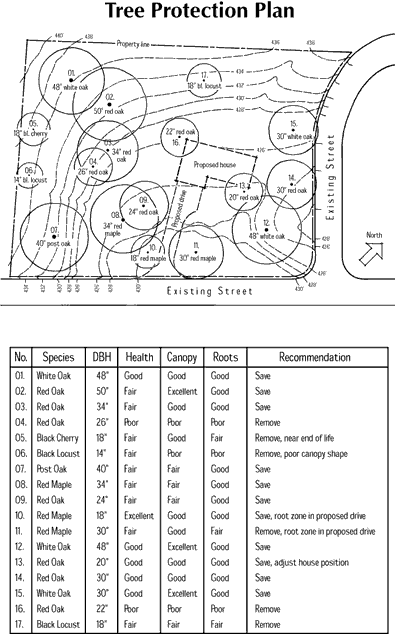
|
| Figure 1. The initial site survey of a wooded lot should note the locations of all trees to be saved and delineate root protection zones. Planning well in advance of construction makes it possible to adjust the position of the house to accommodate desirable trees. |
Hiring an arborist. If a site contains a
large number of desirable trees, you may want to hire a tree-care professional
to assist in planning, and possibly to monitor tree protection as the job goes
ahead. If you take this route, it’s best to hire an arborist certified
by the National Arborist Association or the International Society of Arboriculture
(see “For More Information” at the end of this article). A certified
arborist will have experience with a wide range of tree-related issues, including
which species of trees survive best in a given area, which trees have invasive
roots that can cause foundation or drainage problems, and how to recognize existing
diseases or injuries that may mean a tree is past saving.
The cost of hiring the arborist depends on the house and the scope of the project. In general, it will run from several hundred dollars for a plan review and site visit to several thousand for a full consulting service.
The one-inch rule. Trees to be saved should be identified on the site map with a circle representing the root protection zone. That area is off limits. No construction activity can occur in that zone — that means grading, digging, storing of materials, and all traffic. Contrary to popular wisdom, extending the protective zone to the edge of the tree canopy — the so-called drip line — isn't nearly enough. For best results, the radius of the protective zone should be about twice the tree's height. If the presence of other trees makes it difficult to estimate height accurately, allow one foot of protective radius for each inch of trunk diameter, as measured at breast height.
Preventing Invisible Damage
Why so much space? The answer is that trees don't actually grow the way most
of us think they do. The notion that a tree's root system is a sort of mirror
image of the tree itself — reaching deep underground and extending to the
edge of the canopy (Figure 2) — is inaccurate and misleading. In reality,
most of a tree's root system lies within 18 inches of the surface. The one deep
root, or taproot, provides stability. The fine "feeder roots" that provide most
of the moisture and nutrients the tree needs to survive are concentrated in the
outer portion of the root zone, extending farther each year as the tree
grows.
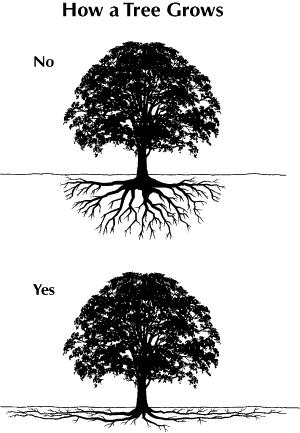
|
| Figure 2. While tree roots are often assumed to reach deep underground and extend outward to the drip line (top), they are actually shallower and much wider reaching (bottom). As a result, they are far more vulnerable to surface disturbances than many builders and homeowners realize. |
No roots, no tree. If they're not too extensive, injuries to tree trunks and branches may be repairable. Torn bark can be trimmed and broken branches can be pruned with varying degrees of success. But damage to the root system is often fatal, although it may be invisible and the tree may not die for several years.
That's bad news, because it typically costs at least ten times as much to remove a dead tree near a completed house as to remove the same tree on an empty lot. Worse, a tree with a compromised root system is vulnerable to wind throw. If it blows over and lands on the homeowner's house or vehicle, you could even be in for a lawsuit.
The worst thing you can do, in other words, is go to the trouble and expense of working around a tree for the duration of the job, only to have it die eventually anyway. The value of a good site plan is that it allows you to divide the trees on a site into three groups: The first group consists of trees that are far enough from the construction zone that they'll survive without special care. The second includes desirable trees that are threatened but can be saved by planning the work around them and taking appropriate protective measures. And group three is made up of those trees that are just too near ground zero to survive.
The 60% threshold. It's not always easy to decide which trees to write off, and you may want to get an expert opinion from an arborist before you consign a valuable tree to the chipper. But a good general rule is to gauge how much of its root system can be expected to remain intact after construction. An otherwise healthy tree will probably survive if at least 60% of its roots are undamaged. If the damage is likely to exceed that figure, it's probably best to cut the tree at the outset and move on.
Tree Protection Basics
The most obvious source of damage to tree roots is the cutting that results
from excavation, grading, and road building. A tree growing at the edge of a
foundation, for example, is almost always doomed (Figure 3). But it's important
to realize that the damage results from the fact that roots have been severed
and has nothing to do with the width of the cut. A 4-inch-wide trench for a
buried sprinkler-system line trench is as damaging to the adjacent trees as a
20-foot road cut. In either case, the severed roots beyond the cut line are no
longer able to supply the tree with nutrients.
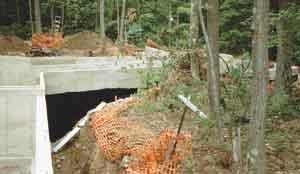 |
| Figure 3. Don't try to save trees that can't be saved. The oaks at the edge of this foundation have lost too many of their roots to survive for more than a few years. It would have been cheaper and much less troublesome to remove them before starting to build. |
To minimize that sort of damage, make a point of running buried utilities along the edge of the driveway, rather than making a series of root-cutting excavations (Figure 4).
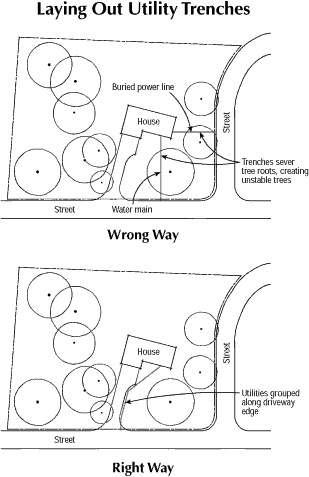 |
| Figure 4. Running buried utilities in a series of radiating or parallel trenches creates isolated strips or islands of trees with damaged root systems (top). Bundling utilities in a single trench along the edge of the driveway keeps damage to a minimum and reduces the risk of wind throw (bottom). |
Soil compaction. In order to convert stored sugars and starches into energy, the living cells in a tree need to take in oxygen and give off carbon dioxide as a by-product. (The exception to this general rule, as you may remember from fifth grade science, are the cells in the leaves, which use carbon dioxide and give off oxygen during photosynthesis.)
This sort of gas exchange is no problem for the aboveground portions of a tree, but the roots' ability to breathe depends on the microscopic pores that are normally found between grains of soil. If the ground is packed hard by vehicular traffic, or even heavy foot traffic, gases can't pass through and the tree eventually suffocates. It's just like putting a plastic bag over your head.
Keeping workers out of the woods. Control
soil compaction by installing protective fencing before any work begins. Snow
fence isn’t substantial enough. It should be rugged, like an anchor fence
or one built with 2x4s. Fencing must be high enough to be seen by operators
of heavy equipment
and completely enclose the root zone, or workers will find a way to maneuver
their trucks under the tree in search of lunchtime shade. Never store building
materials beneath a tree you hope to save (Figure 5).
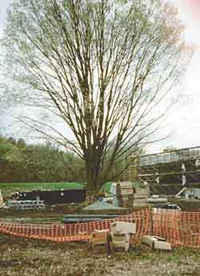 |
Figure 5. Although the root zone of this tree was defined with snow fencing, lack of adequate site supervision made that a wasted effort (top). The broken limb and damaged bark on the tree at bottom are the most visible injuries, but the excavated material piled beneath it will soon suffocate the roots. |
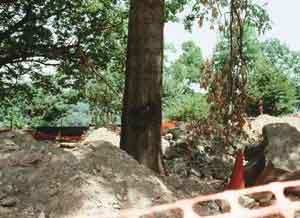 |
|
Saving Trees During Construction, continued
Many builders use a bulldozer to clear unwanted trees and brush away from trees that they intend to preserve. This is a terrible idea. Even if the operator is skilled enough to skim off unwanted vegetation without cutting roots or changing the grade, the weight of the machine will harm trees by compacting the soil. Clearing unwanted trees by hand may be slower and more expensive, but it's far less damaging (Figure 6).
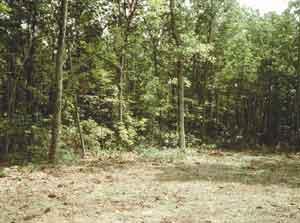 |
| Figure 6. The area in the foreground has been leveled for a new lawn, but the trees beyond have been left untouched and will survive. If necessary, the area can be thinned later by hand, minimizing the risk of mechanical damage and soil compaction. |
Grade changes. Lowering the grade around a tree is another surefire way to destroy its root system. This often results in a virtually rootless tree on a little mound, looking something like the lone palm tree on a cartoon desert island (Figure 7). If the grade change is unavoidable, it's better to cut down the tree immediately, rather than leaving it to be toppled by the first strong wind.
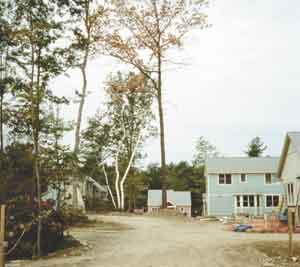 |
| Figure 7. Lowering the grade around this oak has left it with practically no root system. The thin and discolored foliage shows that it's already dying. The inhabitants of the blue house at right might want to sleep in the basement on windy nights. |
Raising the grade by piling soil around the base of a tree destroys its roots by depriving them of oxygen. A good guide is to maintain the root flare at the bottom of the tree. Some professionals claim you can add 2 or 3 inches of well-draining topsoil to an older, well-established tree and get away with it, but our experience suggests that it's best not to add any soil.
If there's no way to avoid substantially raising the grade around a tree, it's sometimes possible to save the tree by enclosing it in a tree well. Unless this is done correctly, though, it's a waste of time and effort. Simply building a stone wall around the trunk won't do it, because the rest of the root zone will be deeply buried and suffocated. A properly constructed tree well must include a network of vertical bell tiles that act as snorkels to supply air to the entire root system (Figure 8). Because this typically costs several thousand dollars per tree, it's seldom a practical option. You're better off working with the existing contour of the land if at all possible.
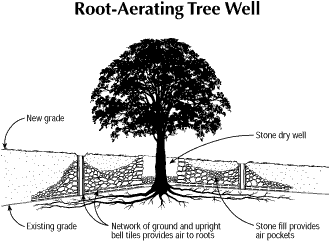
|
| Figure 8. If there's no way to avoid raising the grade around a tree, it might be saved by constructing a root-aerating tree well around it. This is an expensive option and one that is best left to an experienced arborist. |
Paving and drainage. Paving over a tree's roots is another common cause of root suffocation. If a drive or walkway must be located in the root zone, consider surfacing it with brick, gravel, or crushed stone instead of asphalt. Another option is to use "porous pavers" — paving blocks with ornamental cutouts that allow for the passage of air and water.
Finally, make sure that storm runoff won't pool around a tree, or you risk drowning it. And make sure that no one washes down equipment near desirable trees. Trees are sensitive to chemicals, and concrete residue washed from a truck affects the pH of the soil. Petroleum washed from equipment also hurts, as does the calcium chloride that is often used to control dust. Like other salts, it draws water from plants and seals the soil's surface, smothering roots.
Following Through
Critical decisions are made during the design phase, but follow-through makes
or breaks a project. Tree preservation is an unusual concern for many workers,
and you can be sure that some will think the extra care required is a bunch of
baloney. Meet workers as they arrive on the site, explain the ground rules, and
keep an eye out to ensure compliance. If you'll be working with an arborist, he
or she can oversee field implementation, but the most effective policy is to
have the arborist advise a fully invested site supervisor.
Paul Fisette is director of the Building Materials and Wood Technology Program, and Dennis Ryan is director of the Arboriculture and Urban Forestry Program, both at the University of Massachusetts in Amherst.
This article has been provided by www.jlconline.com. JLC-Online is produced by the editors and publishers of The Journal of Light Construction, a monthly magazine serving residential and light-commercial builders, remodelers, designers, and other trade professionals.
Join our Network
Connect with customers looking to do your most profitable projects in the areas you like to work.

